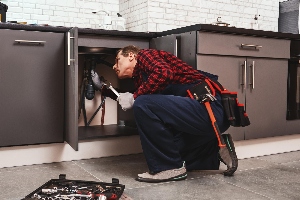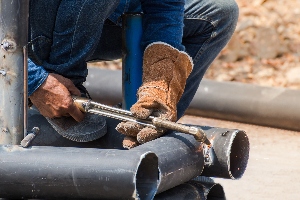Keeping your sewer lines in optimal condition requires regular inspections. Here at One Call Plumbing, we employ advanced sewer line inspection methods to ensure your plumbing system runs smoothly. These inspections help identify issues early, preventing costly repairs and maintaining the safety of your property.
Let’s talk about sewer line inspection, identifying issues, environmental and health considerations to sewer line inspections, and next steps to keep your home in healthy standing.
Basics of Sewer Line Inspection
Sewer line inspection is crucial for maintaining a healthy plumbing system. It involves identifying issues such as clogs, cracks, or tree root infiltration, which can lead to significant damage if not addressed promptly.
Understanding Sewer Systems
Understanding the components and function of sewer systems is the first step. Sewer lines connect your property's plumbing to the municipal sewer system or septic tank. These pipes, often made from materials like PVC, cast iron, or clay, transport wastewater away from your home.
Several factors can affect sewer line health, including age, material, and soil conditions. Over time, pipes may corrode or develop cracks which can compromise their integrity. Regular inspections help detect these issues early, preventing costly repairs.
Common Issues in Sewer Lines
Common issues in sewer lines include blockages, leaks, and obstructions. Blockages often arise from items like grease, hair, or foreign objects, causing reduced water flow. Tree roots seeking water sources can infiltrate and damage pipes, leading to severe blockages and leaks.
Pipe material and age also contribute to sewer line problems. Older clay or cast iron pipes are more prone to corrosion and cracks. These conditions can lead to significant damage, requiring professional intervention.
Inspection Techniques and Equipment
At One Call Plumbing, we utilize the latest technology and proven methods to inspect sewer lines effectively. This ensures accurate diagnoses and swift resolutions to any issues you may face.
Camera Inspections Explained
Our team leverages advanced sewer inspection cameras to provide a detailed visual analysis of your sewer pipes. This technology features a flexible cable with a high-resolution camera that can navigate through twists and turns in the sewer line. By transmitting real-time footage to a monitor, our technicians can identify blockages, cracks, or other issues without any guesswork. This method is invaluable for pinpointing the exact location and nature of a problem, making repairs more efficient.
From Visual to Tactile Inspections
While camera inspections offer a detailed view, visual inspections conducted by our experienced technicians are equally essential. During a visual inspection, our professionals look for external signs such as foul odors, slow draining, or water pooling, which can indicate underlying issues. Additionally, tactile inspections are performed using tools like a drain snake to manually detect and clear any blockages. This comprehensive approach ensures that no detail is overlooked, providing a thorough analysis of your sewer system’s health.
Innovations in Sewer Inspection Equipment
Staying at the forefront of innovation, our team employs state-of-the-art technology to enhance inspection accuracy. Alongside inspection cameras, we utilize equipment such as sonar detection and hydro-jetting tools. Sonar detection helps to map underground pipes and identify any deformations or blockages. Hydro-jetting, which uses high-pressure water jets, is effective for both inspecting and clearing blockages. These innovations ensure that our inspections are precise, non-invasive, and highly effective in maintaining your plumbing system.
The Impact of Location, Age, and Maintenance
Inspections of sewer lines are essential for identifying potential problems early. Factors like the location of your property, the age of your infrastructure, and regular maintenance practices can significantly influence the condition of your plumbing system.
Location-Related Challenges in Inspection
The location of your property poses unique challenges for sewer line inspection. Urban areas may have older sewer systems that are more prone to issues, while rural locations may face challenges with more extensive septic fields. Each environment offers distinct obstacles.
For instance, urban locations often require navigating complex networks of pipes. This typically involves working with municipal regulations. In rural areas, accessibility to certain sections of the septic or sewer system may be limited, making inspection more challenging.
Proximity to natural features like trees or bodies of water can also affect sewer lines significantly. Roots can infiltrate and damage pipes, and ground shifts near water sources might lead to breaks or collapses.
Aging Infrastructure and Inspection Needs
The age of your plumbing system is a crucial factor. Older systems, especially those constructed before modern standards, are more susceptible to wear and tear. Materials like cast iron and clay, common in aging infrastructures, tend to deteriorate faster.
Over time, pipes may develop cracks, rust, or complete collapses. They require more frequent and detailed inspections. Older systems may also lack efficient design elements seen in newer constructions, making problems harder to detect without sophisticated equipment.
Routine maintenance and inspections must be more consistent for older structures. It helps in identifying issues like blockages, leaks, and corrosion early on, preventing extensive damage.
Maintenance: Prevention and Early Detection
Routine maintenance is critical for the health of your plumbing system. Regular checks and timely repairs can prevent small issues from becoming significant problems. Maintenance helps in early detection, which can save you from costly repairs later.
Inspection methods like using advanced camera technology and specialized leak detection tools are imperative. They allow you to catch potential issues before they escalate. Regularly scheduled maintenance also ensures compliance with local regulations, especially in commercial settings.
Environmental and Health Considerations
Proper sewer line inspections are crucial for maintaining a healthy environment and safeguarding public health. We focus on identifying issues early to prevent environmental contamination and health hazards.
The Environmental Impact of Sewer Issues
Sewer line problems can lead to significant environmental concerns. When sewer lines are compromised, untreated sewage can seep into soil and water sources, causing contamination. This not only affects the local ecosystem but also poses risks to agricultural lands and wildlife. Sewer overflows can lead to the proliferation of harmful bacteria and viruses, which negatively impact natural water bodies.
Public Health and Sewer Line Conditions
Compromised sewer lines pose direct threats to human health. Untreated sewage contains various pathogens that can lead to widespread illnesses, including gastrointestinal infections and other serious health conditions. Sewer overflows in residential areas can increase exposure to hazardous contaminants, endangering public health.
At One Call Plumbing, we prioritize the health and safety of our community. Our professional services include thorough inspections, precise leak detection, and timely repairs. By using cutting-edge technology, we ensure that your plumbing system remains efficient and safe, minimizing the risk of health hazards associated with sewer issues.












